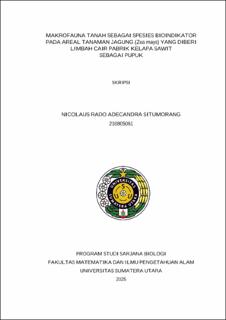Makrofauna Tanah sebagai Spesies Bioindikator pada Areal Tanaman Jagung (Zea mays) yang Diberi Limbah Cair Pabrik Kelapa Sawit sebagai Pupuk
Soil Macrofauna as Bioindicator Species in Corn (Zea mays) Cultivation Area Treated with Liquid Waste from Palm Oil Factories as Fertilizer

Date
2025Author
Situmorang, Nicolaus Rado Adecandra
Advisor(s)
J, Arlen H
Metadata
Show full item recordAbstract
Soil macrofauna are soil animals that live the surface at in the soil that have a body length of biggh than 2 mm. This research was conducted in corn area Samosir Regency. The material used was palm oil mill effluent as organic matter containing nutrients needed by plants. This study aimed to analyze the presence, density, relative density, and frequency of occurrence of soil macrofauna species as bioindicators in corn (Zea mays) plantations treated and untreated with POME (palm oil mill effluent) as fertilizer. The research was conducted in Lumban Suhi- Suhi Toruan Village, Pangururan District, Samosir Regency, North Sumatra. Soil samples were collected using the quadrat and handsorting methods in 30 plots (15 control and 15 treated). The results showed that more macrofauna species were found in the treated plots (26 species) than in the control plots (11 species). The dominant species with potential as bioindicators based on relative density ≥ 10% and frequency of occurrence ≥ 25% were Pontoscolex corethrurus and Forficula smyrnensis. The use of POME improved macrofauna diversity and density and enhanced the physical and chemical properties of the soil such as pH, temperature, soil moisture and soil nutrients. Therefore, palm oil mill effluent can be used as an eco-friendly organic fertilizer for dry agricultural land.
Collections
- Undergraduate Theses [977]
